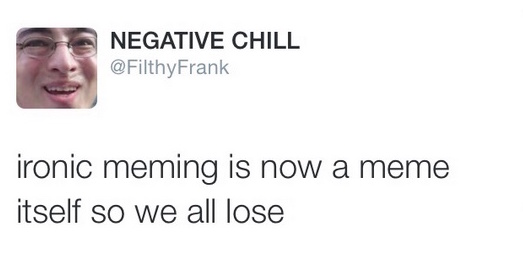
A few days ago, at La Scuola Open Source, one of the things I discussed was the relationship between irony and precarity. Since it’s a common artistic rhetorical tool, questions about irony are frequent. Whenever this happens, I think of two opposite arguments about it. The first is by Mark Fisher, who in Capitalist Realism identifies irony as the typical expression of the post-modern condition, in which there is no way of engaging with societal issues. The second is by Franco ‘bifo’ Berardi, who in Heroes declares that irony must oppose the tragic seriousness of life under semiocapitalism.
During my talk, I proposed a form of ironic attachment (an ironic attitude that doesn’t lead to immobilization, irony that produces proximity, irony that becomes action) in opposition of the dominant detached attitude that characterizes ironic statements. Yesterday, I found by chance the perfect example of this detachment which allows me to better understand what ironic attachment can be.
In a short interview, the founders of an advertising agency called Young Poor Artists are asked to give tips to young artists in order to not stay poor. Here’s their answer:
Wealth is immeasurable, it’s individual. One artist may work with a project worth many thousands and struggle because he needs few thousands more. And the other one may do just great because he purchased a pack of new oil paint. The idea behind poor is precisely conceptual. Artist’s wealth is his/her ideas and motivation. As long as you move forward nothing else matters. Artist is not entrepreneur but he/her may become one.
Poverty is described as an individual, relative and ultimately "conceptual" issue. Yet, the suggestion for the poor artists is to become entrepreneurs. Ironic, isn’t it?
Maybe ironic attachment can emerge from such cases, as a sort of meta-irony, which involves the capability and willingness to find ironic detachment ironic in itself, by relating it to societal and structural conditions. Let’s scale up.
P.S. Thanks to the comments of a colleague, I realized that the example I provide is not as self-evident as I thought. So I’d like to elaborate a bit more.
Apparently, the main feature of irony is that “the surface meaning and the underlying meaning of what is said are not the same”. In my example, there are two facts:
- an advertising agency decides to call itself “young poor artists”
- the agency gives tips on how not stay poor and frames poverty as a conceptual issue
Fact 1 is ironic because an advertising agency is meant to make money and therefore shouldn’t be run by young poor artists.
At first sight, fact 2 is not ironic. However, drawing an ironic link between these two facts implies taking into account societal issue like, among others, increased precarization. Without this societal lens, we are merely left to get the joke in fact 1.
On the contrary, if we bear precarization in mind, the suggested relativization of poverty as mindset can be perceived as ironic, or meta-ironic. The surface meaning (“poverty is relative”) is contradicted by the underlying meaning (“poverty is real, material, and affects many young poor artists”). Therefore, I’d suggest to consider ironic attachment as an approach to irony that’s fuelled by concerns about society.
